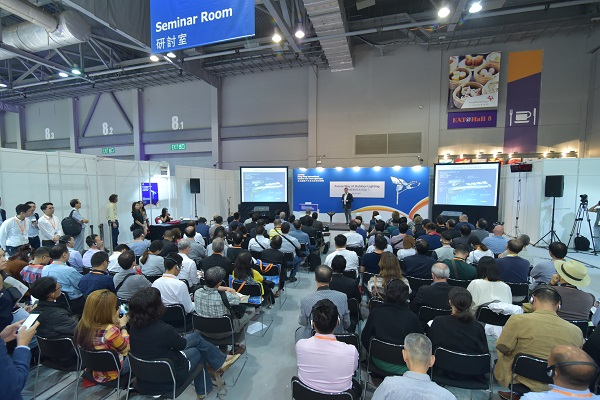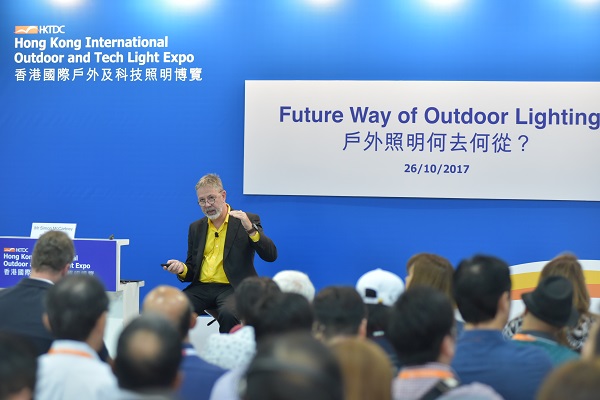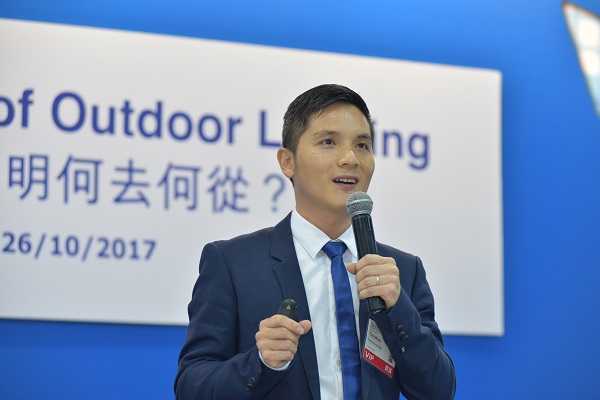A highlight event, the "Future Way of Outdoor Lighting" seminar of the second Hong Kong International Outdoor and Tech Light Expo, organised by the Hong Kong Trade Development Council (HKTDC), was held on 26th October 2017. The seminar attracted around 200 key industry players to participate and exchange innovative ideas on cutting-edge outdoor lighting technologies.
Held at the AsiaWorld-Expo, three international outdoor lighting experts were invited to share their knowledge and insights at the seminar - Editor-in-Chief and Managing Director of Highlight Magazine Markus Helle, Co-founder of Illumination Physics Simon McCartney, and Senior Manager (Product Management) of Zumtobel Group Asia Pacific Tung Wong. The content of the seminar was as wide-ranging as the industry itself from market demand and trends in outdoor lighting, opportunities and challenges in facade lighting design to stadium lighting.
 |
|
(Image: the Hong Kong Trade Development Council) |
Smart lighting to enhance the quality of life
As the Editor-in-Chief and Managing Director of Germany's leading lighting magazine Highlight, Markus Helle is familiar with the latest innovations and developments in outdoor lighting. During the presentation, he gave participants a comprehensive overview of German lighting technologies, focusing on outdoor lighting and the key future trends for public and private lighting.
"There are 9.5 million street lights in Germany, and more and more of them have been switched to LEDs, whose higher energy efficiency, greater durability and lower exchange rates save both capital and recurrent costs. Moreover, with environmental champions encouraging stakeholders to replace current public lights by LEDs, the LED market is growing rapidly," Helle said.
Nevertheless, Helle pointed out that it takes a long time to go through the decision-making process for procurement of public street lighting, since the mechanism is sophisticated and the composition of decision makers, including town administrations, municipalities and government officials, is complex and lengthy. Introducing the smart city concept, he explained that Germany is not only centralising the control of street lights by connected computer systems, but it has also installed sensors on some public lights to gather data on the environment and people. For instance, if there is a midnight event in a part of the city, the lights can be programmed to function in designated area.
Driven by rapid advances in the technology of lighting, lighting intelligence now runs from the city to every home, with LED outdoor lights for private homes becoming more popular due to low energy consumption and smart sensor controls. LEDs and integrated sensors have enhanced people's quality of life, and can assist in a wide range of applications, such as adjusting the brightness and other controls of light on surveillance cameras outside homes. Such functions can also be seamlessly synchronised with mobile devices. In addition, some households are even installing solar panels in the open space outside their homes to generate green energy to power their smart outdoor lighting.He highlighted that the same, sensor-detect technology has also been applied to smart car headlights of leading automakers in Germany, "The technology is getting smarter and smarter, which enables the headlights of automobiles to detect a person easily to prevent road accidents." Helle shared.
 |
|
(Image: the Hong Kong Trade Development Council) |
From evolution to revolution in outdoor lighting -- communicating to viewers
Simon McCartney, the laser show designer for "A Symphony of Lights" - a popular nightly light show at Victoria Harbour in Hong Kong, delivered his presentation on the key trends in facade lighting at the seminar. He and his team have recently designed, manufactured and installed facade lighting for buildings, such as malls, casinos, hotels and residential apartments. Other than providing safety and energy-saving lights, McCartney revealed that they are also working on many projects to revitalise older buildings to make them look more modern, artistic, and at the same time adding character and ambiance to an outdoor space through creative outdoor illumination. "It is important to add unique character to the lighting of buildings, as it can make a building stand out clearly and elegantly at night from the concrete forest," he added.
McCartney noted that the outdoor light revolution has begun but "inauspiciously, as the product designers were not the installers", and while the architects are the ones to design and structure the buildings, they are not obligated to cater the needs for outdoor illumination instalment. "Therefore, the outdoor lighting industry is facing many challenges and needs to develop innovative and creative solutions when it comes to the projects of 'lighting up' or 're-lighting' older buildings, which were not designated for outdoor lighting."
According to McCartney, lights were traditionally used to fit the facade and were designed to reduce energy consumption, mitigate sky glow and yet be bright enough to be spotted. Nevertheless, new innovations and products have sprung up throughout the industry, even a "media wall" with practically transparent material can now be "invisibly" installed on the facade of buildings. McCartney cited HSBC's main building in Central as a successful example, with its media wall, which he and his team described, "truly communicating with its viewers."
 |
|
(Image: the Hong Kong Trade Development Council) |
Evolution of stadium lighting -- towards enchantment of audiences and broadcasting perfection
The last presentation of the seminar was given by Senior Manager (Product Management) of Zumtobel Group Asia Pacific Tung Wong, an expert in lighting and telecommunications, who has been engaged in the outdoor and stadium lighting industry for over 16 years. He shared the evolution he had witnessed over the years with regard to stadium lighting.
According to Tung Wong, nearly 95 per cent of the stadiums and arenas around the world are still using conventional lighting modules, which take 20-30 minutes to run and warm up for maximum system brightness. He highlighted that a new high-tech illumination system has recently been developed, which could reach its optimum effect immediately when it is switched on, even just right before kick-offs of sports matches and celebrity shows.
"I would say we are now so near to a lighting revolution of sports and stadium lighting. A new generation of lighting system has truly emerged." Mr Wong said, with excitement, to a captivated audience of outdoor lighting industry professionals.
 |
|
(Image: the Hong Kong Trade Development Council) |
Mr Wong then explained the key major advantages of the new generation of lighting systems over conventional systems. For instance, innovative new systems can provide a pleasant and unique visual experience to audiences, create atmosphere in the stadium and enhance the safety, sophistication and reliability of the overall lighting system. With the above strengths, he was sure that the new generation of lighting systems being introduced would genuinely enhance audience experience. "It's all about users' experiences - can you imagine sports stadiums transforming into theatres and giving a fantastic event experience and entertainment to audiences? Can you feel how fantastic and transformative that will be?" Mr Wong explained, in praise of high-tech systems for stadium lighting.
In sharing his views on the latest developments in broadcasting technology, Mr Wong emphasised the important role of a new generation of smart and digitally connected LED lighting systems to create the "perfect broadcasting experience" in stadiums and sports arenas.











